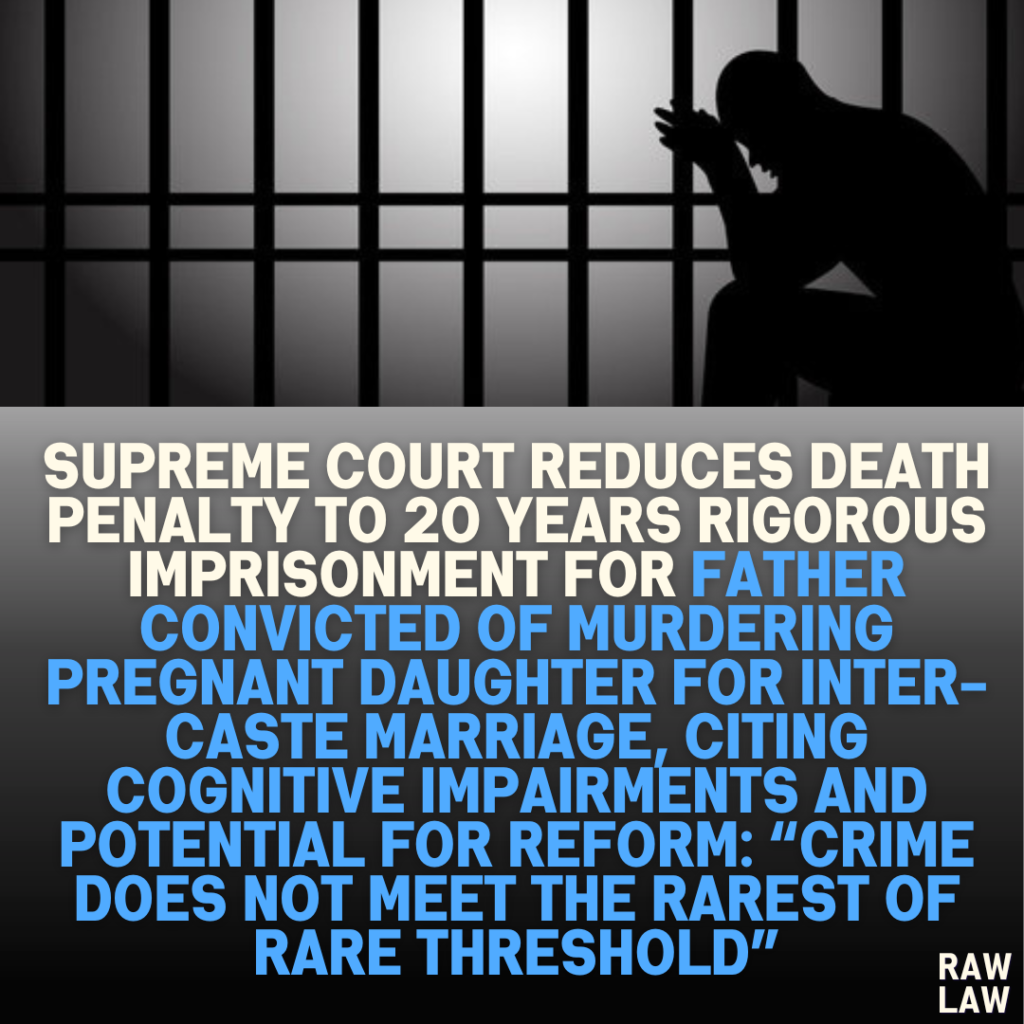Court’s Decision:
The Supreme Court of India upheld the conviction of the appellant under Sections 302, 316, and 364 of the IPC for the murder of his pregnant daughter. However, the Court reduced the death sentence to 20 years of rigorous imprisonment without remission, emphasizing that the doctrine of “rarest of rare” must account for the possibility of reformation.
Facts:
The appellant, the father of the deceased, was charged with murdering his daughter, who had married outside their caste. On June 28, 2013, the appellant lured his daughter, Pramila, away from her home under the pretext that her grandmother was ill. He then strangled her in an autorickshaw using a rope. Despite attempts by witnesses to save her, Pramila succumbed to her injuries. The prosecution argued that the appellant was motivated by the dishonor he felt due to his daughter’s inter-caste marriage.
Issues:
- Whether the appellant was rightly convicted under Sections 302, 316, and 364 IPC.
- Whether the death penalty should be maintained or commuted.
Petitioner’s Arguments:
- The motive for the murder was not proven, and the prosecution’s case was based on vague assertions.
- The eyewitness (PW2) was unreliable due to prior financial disputes with the appellant.
- There were contradictions in the testimonies of key witnesses (PW1 and PW3), and independent witnesses were not examined.
- The seizure of the rope used in the murder was not properly established.
Respondent’s Arguments:
- The prosecution successfully proved the appellant’s motive and the chain of events leading to the murder.
- Eyewitness testimony, medical evidence, and circumstantial evidence corroborated the prosecution’s case.
- The crime was a “rarest of rare” case, warranting the death penalty due to its heinous nature.
Analysis of the Law:
The Court considered the principles laid out in Bachan Singh v. State of Punjab and Madan v. State of Uttar Pradesh, which emphasize that the death penalty should be imposed only in the “rarest of rare” cases where the possibility of reformation is ruled out. The Court examined the mitigating factors presented, including the appellant’s socio-economic background, lack of criminal antecedents, and the possibility of reformation.
Precedent Analysis:
The Court relied on past judgments such as Vadivelu Thevar v. State of Madras (on the sufficiency of a sole eyewitness) and Swamy Shraddananda (2) v. State of Karnataka (on commutation of death sentence to life imprisonment in cases where reformation is possible). The Court also considered judgments like Rohtash Kumar v. State of Haryana regarding the treatment of minor discrepancies in witness testimonies.
Court’s Reasoning:
The Court found that while the crime was heinous, it did not meet the threshold of “rarest of rare” due to the mitigating factors presented, including the appellant’s background, his cognitive impairments, and satisfactory conduct in prison. The Court reasoned that the appellant was not beyond reform and that imposing the death penalty in this case would not serve the interests of justice.
Conclusion:
The Supreme Court affirmed the appellant’s conviction for murder but reduced the death sentence to 20 years of rigorous imprisonment without remission, ensuring that the appellant would serve the full term without any possibility of early release.
Implications:
This judgment reaffirms the principle that the death penalty should only be imposed in the “rarest of rare” cases, taking into account the possibility of reformation. The Court’s decision emphasizes a balanced approach, recognizing both the gravity of the crime and the appellant’s potential for rehabilitation.




Pingback: Gauhati High Court Upholds Demand for Central Excise Recovery, Dismisses Plea to Reopen Settled Case on Grounds of Finality of Prior Orders - Raw Law